What do projection systems like SP+ (newly re-named!) and FEI see for Notre Dame in 2019? A much more difficult schedule, an improving offense, and a defense that will hope its strength in the passing game helps it continue to be a top-10 unit.
Transparently, this was intended to be a multi-part series, but hey, the season is almost here! Let’s start with a breakdown of the Notre Dame offense and defense, then look at the toughest opponents this year and how the schedule might shake out.
Notre Dame Offense
A virtual lock to improve
It wasn’t the path anyone expected, but the Irish finished 33rd in Offensive SP+ after the Cotton Bowl loss to Clemson. The offense struggled to find consistency in the first three games under Brandon Wimbush – not surprising against Michigan, but certainly concerning against Ball State and Vanderbilt. The change to Ian Book was a minor shock, but ushered in an entirely different offensive profile than in 2017.
It’s a bit messy combining the combination of Wimbush and Book starts, but the 2018 offense was a high-efficiency passing offense that finished 23rd in Passing SP+ after finishing 58th the previous season with Wimbush starting almost every game. The running game, which had finished 4th in Rushing SP+ in 2017, dramatically felt the loss of Josh Adams, Quenton Nelson, and Mike McGlinchey, falling all the way to 72nd.
Transitioning to 2019, it’s hard to see the offense not improving from a season ago with the returning pieces in place. SP+ sees some returning production questions with the needed replacements for Dexter Williams, Miles Boykin, and Alize Mack, but there’s a strong mix of talent and experience back-filling each. The passing attack should be at least a little stronger than a year ago with a more experienced Book looking frequently at reliable options in Chase Claypool and Chris Finke.
The running game, despite losing Williams’ explosiveness, likely hit its floor with poor run blocking a year ago that handicapped run efficiency. With four starters on the offensive line returning, the Irish at a minimum see a large uptick in run success rate that balances out potential losses in explosiveness, and maybe even without a big trade-off.
A top-25 offense feels like a lock, but how high can the Irish go? SP+ surprisingly projects the Irish just 29th on offense, FEI 11th. A deeper dive into the pass and run games can illuminate the reasons for optimism and concern.
A high-floor, efficient pass offense – where’s the ceiling?
The passing game floor and ceiling probably starts with Ian Book. No matter what metric you prefer – ESPN’s QBR, passer rating, yards per attempt – Book was clearly a top-20 quarterback last year, and arguably top-10. His accuracy came to be his calling card, especially in the short and intermediate range. And as Pro Football Focus highlighted, Book was exceptional when he wasn’t under pressure last season. Those results should only continue to trend positively with the bulk of the offensive line returning that finished 38th in sack rate last year, including 16th on passing downs.

The big questions for Book have been well-documented – can Book anticipate and get more comfortable under pressure, thus avoiding some of the awkward halves like Virginia Tech and Pitt? Can he improve Notre Dame’s downfield passing threat with better deep-ball accuracy, and does he have the targets to stretch the field there? These are nitpicks for a QB with Book’s strengths, but could determine just how dominant the passing game and offense can be.
Another key ingredient will be the returning production at wide receiver. Despite losing Boykin and Mack, two of Notre Dame’s three most targeted receivers, there’s reasons for optimism. Despite a bit less volume in the pass game, Claypool was just slightly less explosive (via yards per target) and slightly more efficient (via success rate when targeted) than Boykin last season. Kmet was more efficient and explosive than Mack last year in a more limited role. Chris Finke brings back a reliable efficiency threat, and Michael Young (when he returns) definitely brings explosive upside. The chart below (with 2018 targets in parentheses) shows the explosiveness and efficiency of each option last year:
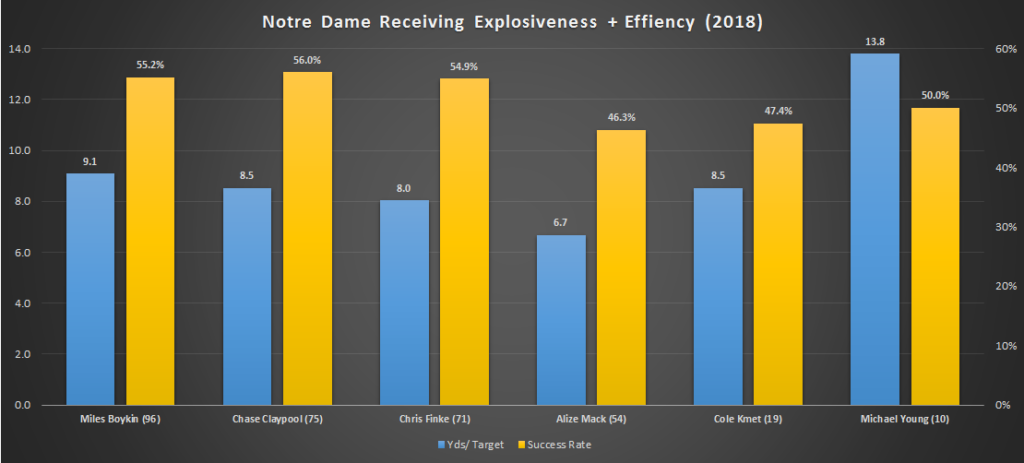
Injuries and the suspension to Kevin Austin have taken a little air out of the upside here, but Finke and Claypool are an extremely solid backbone. If Kmet and Young are returning around the time of key matchups like Georgia, the upside of this receiving group is extremely high. The other underrated element that could be greater incorporated are running backs in the passing game with two excellent receivers in Tony Jones and Jafar Armstrong.
Is the run game a liability, balancing force, or a threat?
As mentioned, last year’s running attack was surprisingly sub-par, even accounting for the losses of two guys who were exceptional NFL linemen as rookies. The guys at Notre Dame Our Blogger (not just documenting NDN insanity!) did a great job capturing the semi-dramatic decline in the run blocking number across the board:
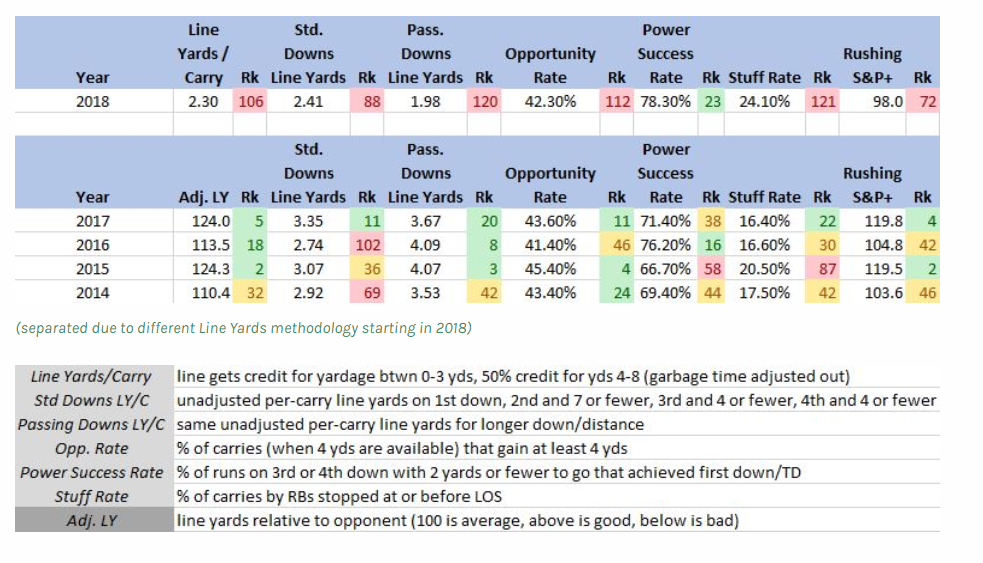
It’s tough to be efficient running the ball with such a poor stuff rate that constantly puts the offense into passing downs. The shocking aspect was the performance not against the Clemson and Michigan defenses of the world, but allowing crazy disruption to teams like Ball State, Northwestern, and USC.
The good news is that the run blocking almost has to be better. The returning OL starters, minus Jarrett Patterson, figure to be healthier and improved in this area. The bad news is it’s such a steep curve for improve to get back to being good in so many of these categories. There is hope though – on paper, there’s really not much of a rational explanation for these struggles with blue chip and experienced talent unless Jeff Quinn is really not good.
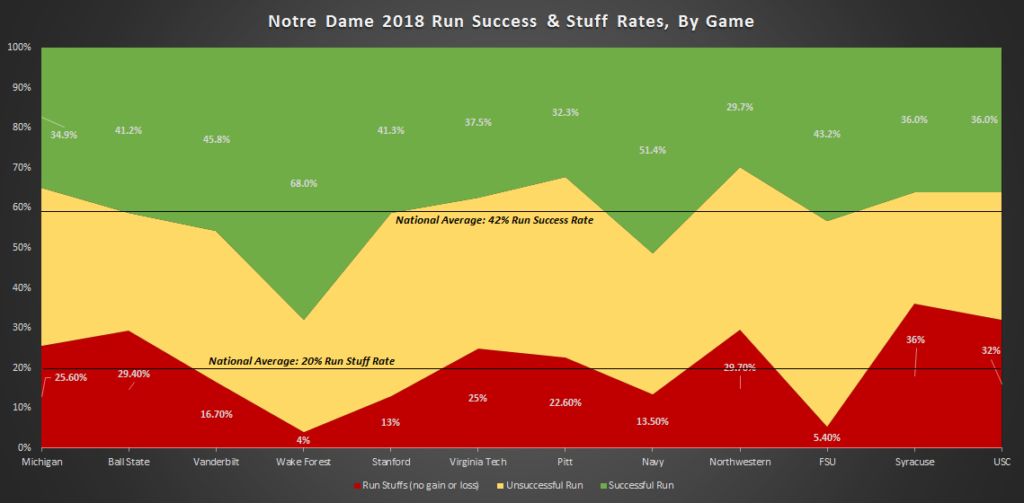
And there’s some decent precedent for this too – for example, UGA finished just 63rd in Rushing SP+ in 2016 despite Nick Chubb and Sony Michel. They were 94th in stuff rate allowed, 113th in power run success, and middling in line yards. The next year, with the same talented but previously struggling OL starters returning, they jumped to 12th in adjusted line yards, 39th in stuff rate, and 6th in Rushing SP+ in their playoff push.
Reason to believe the offense is underrated
The offense is projected 29th by SP+, and even putting aside obvious biases I think there’s a good case for Notre Dame being underrated by the analytics. A major input is last year’s performance, which features three poor offensive games Wimbush started to open the year that drag down that baseline performance. The Irish are also just 86th in returning offensive production, which is weighted most heavily by returning WR yards and QB production.
The receiving production sees Miles Boykin and Alize Mack as huge losses, but relative to other teams Notre Dame seems better positioned to fill that production via talented replacements. QB production is penalized for Wimbush’s departure, but filling that with more Ian Book should actually be a positive development.
The final element I think is underrated is an entire offseason planning the offense around Ian Book’s strengths. Chip Long spent a ton of time and effort leading into 2018 trying to design around a dynamic runner and limited passer, then quickly found himself working with an entirely different skill set when Book took over. The continuity of Book in Long’s scheme, time for Long to install on offense around an extremely accurate short to medium passing game, and growth of the offensive line should all point in the direction of improvement.
So instead of being projected around Mississippi State, UNC, or USC in terms of offense and behind teams like Vanderbilt and Tennessee, in reality I think the offense should be projected 3-4 points higher (among the LSU or Michigan’s of the world, who check in at 14th/15th).
Notre Dame defense
Built for bend but don’t break
The brief Mike Elko – Clark Lea era of Notre Dame defenses have been defined by an absolute refusal to give up explosive plays. This isn’t new – when Elko was hired, his Bowling Green and Wake Forest defenses were consistently better on passing than standard downs. It can be an effective strategy that’s maybe even enhanced with a talent advantage – force offenses to string together lengthy drives to beat you, then capitalize on your chance when penalties or ineffective plays force the offense into obvious passing situations.
Last season that plan was executed to perfection – the Irish were 3rd in marginal explosiveness allowed, not allowing a gain of over 60 yards all season and just five of 40+ (4th nationally). They were excellent in the red zone as well, finishing 3rd in allowing scoring opportunities.
This year’s team may fit even more to this billing if it’s Clark Lea’s design. With the strength and depth at defensive end paired with exceptional safeties, passing downs should be extremely productive for the Irish defense. Standard downs are more of question mark given the relative unknowns on the interior defensive line and at linebacker. If he wanted to Lea could probably manufacture more havoc than 2018, when ND finished 41st in havoc created, if he wanted to. But my guess is that rather than risk the big play, Lea will be content to again keep things in front of his defense, then pounce once there’s a 3rd and long.
A few more questions, including depth, than 2018
SP+ switches places with FEI when it comes to the defense, with Connelly’s system projecting the Irish 9th and FEI 20th. Both systems likely see very strong performance last season, but vary in how well they see the Irish able to return the void in production left by Tillery, Coney, Love, and Tranquill. For what it’s worth, SP+ has found historically that returning defensive back numbers are better correlated with future performance than linebacker or DL numbers, which bodes well for a defense with Troy Pride, Alohi Gilman, and Jalen Elliott.
The peak performance of this defense could definitely repeat as a top-10 unit, but the Cotton Bowl shined a spotlight on the potential weakness with Julian Love’s injury – depth. Aside from defensive end there’s very little proven experience going into the second string at DT, linebacker, corners not named Pride, and safety.
There’s just more question marks with this unit than the 2018 edition, which had many of those answered surprisingly well (remember being worried about safety play and if ND fans would see any disruption from the position?) Who will emerge as the 2nd corner? How good are any linebackers? How will the Irish defense, which finished 21st in Rushing Defense SP+, hold up against good UGA and Michigan lines with Coney, Tillery, and Tranquill gone?
How Clark Lea (who has maybe earned a 100% job approval rating faster than any coordinator in program history) answers these questions will be fascinating. Is he more aggressive with less experienced linebackers, plugging the interior and forcing opponents to run outside against terrific ends and great safeties? Can he get creative with personnel to cover up potential weaknesses in the secondary, including utilizing Kyle Hamilton, the most hyped arrival to campus since the Eddy Street Chipotle?
The schedule
The rare downside of going 12-0 is that any regression in the wins column is going to be seen as a drop in team quality, even if that’s not necessarily the case for a Notre Dame team that’s facing a more difficult schedule in 2019. Looking at preseason SP+ rankings, the schedule breaks down into four clear tiers:
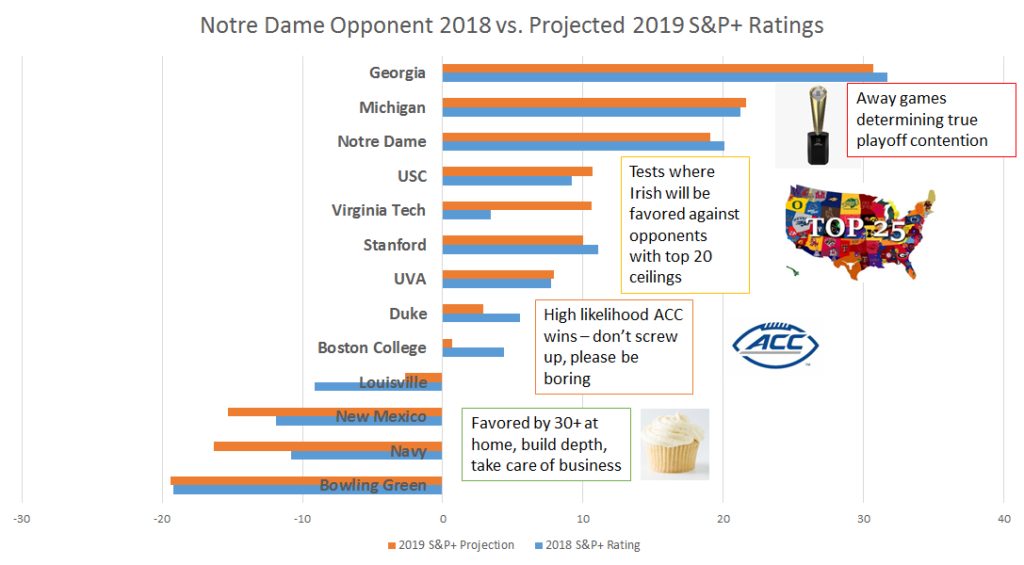
Last season the Irish were favored heading into every single game. In 2019, Notre Dame faces an away game at Athens that SP+ gives them about a 1 in 5 chance to win, and a trip to Ann Arbor where the most likely projection is a loss (I disagree!). The middle tier of the schedule features four teams with top-20 ceilings but floors as low as #50 or so, and thankfully for the Irish three of the four come at home.
It’s interesting to see that SP+ doesn’t project a ton of change from 2018 to 2019 in Notre Dame’s opponents. Some of that is a result of ’18 performance as a strong input to the projections, but a lot of it is that few opponents combine a ton of returning production or losses with particularly noteworthy (good or bad) units from a season ago. Virginia Tech stands out as the big winner thanks to it’s defensive continuity, but notably teams like Stanford and USC that weren’t impressive a year ago don’t figure to improve a ton on paper. Small and grayed out logos below indicate 2018 ratings, with 2019 projections represented with larger logos:
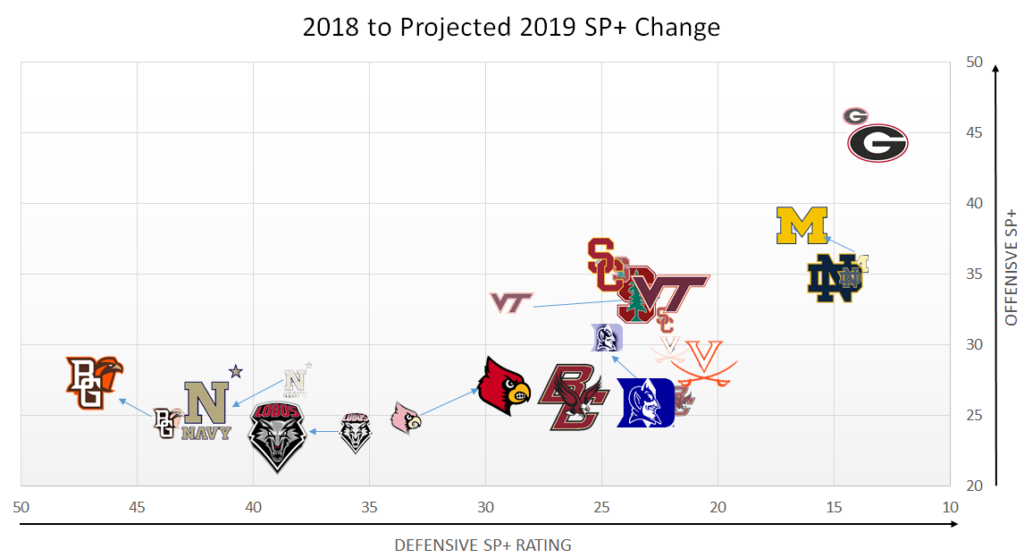
The big games
A quick look into what SP+ thinks of the top six opponents that should make or break a second consecutive playoff push for Notre Dame…
Georgia
Projected SP+ rank: 2nd
Projected margin: -14 (21% win probability)
What SP+ likes: Everything
The Kirby Smart Bulldogs have been a juggernaut that have literally done everything besides win a College Football Playoff. SP+ rates them 2nd in terms of returning production, when weighted for 2018 performance, 2nd in recruiting talent, and 7th in weighted 5-year performance. The offense and defense have both been top-10 quality the past two seasons. There is significant roster turnover, but the Bulldogs last few recruiting classes (6th in 2016, 3rd in 2017, 1st in 2018, 2nd in 2019 per the 247 Composite Rankings) put them in recent Saban/Meyer territory in terms of reloading from a stocked cupboard of blue chips every year.
What SP+ doesn’t like: Personnel losses, especially at WR
The Bulldogs returning production ranking isn’t indicative of a team bringing all its key contributors back, just one that’s been so strong and is so well equipped that those losses are unlikely to result in a big drop in quality. The Dawgs return only 53% of their offensive production (receiving yards, passing yards, rushing yards, OL starts) per the SP+ returning production numbers, 99th in FBS. That feels surprisingly low for a unit that returns a top Heisman contender in Jake Fromm, one of the nation’s best backs in Deandre Swift, and possibly the best offensive line nationally.
But all of the top receiving options are gone. And as Notre Dame fans may remember from 2016, returning WR are the most strongly correlated offensive factor in year to year performance. The leading receiver coming back by catches and yards is Swift at running back. The most productive returning WR, Tyler Simmons, had 9 catches and 138 yards in 2018. There’s a depth chart full of blue chippers, including transfer and erstwhile Irish recruiting target Demetris Robinson, but exactly zero proven options.
What SP+ doesn’t know: Will UGA be the best version of itself by the time the Irish visit Athens?
On paper, early in the year seems like favorable timing to be playing the Bulldogs. Georgia’s talent level entering year four of the Smart era is competitive with some of the best years of Saban in Tuscaloosa and Urban’s runs on Ohio State. But the rich program problems that can come with the inevitable year to year turnover of early entries can also turn into a limiting factor, and it’s plagued UGA’s conference mates like LSU over time.
Georgia is immensely stable and loaded with talent on both sides of the ball, yet they have distinct question marks coming out of 2018. A few of the top ones that may take time to solve:
- Can James Coley solve the Dawgs red zone woes?
Georgia’s offense was terrific under OC Jim Chaney (now departed to Tennessee) until the field shrank. From our new world wide leader, Bill Connelly, in his SEC title game preview:
- In open play (snaps between the offense’s 10 and the defense’s 30), Georgia’s success rate is 54.1 percent, third in FBS.
- Between the opponent’s 21 and 30, Georgia’s success rate is 48.8 percent, 19th.
- Between the opponent’s 11 and 20, Georgia’s success rate is 46 percent, 26th.
- Inside the opponent’s 10, Georgia’s success rate is 40 percent, 116th.
- Inside the opponent’s 3, Georgia’s success rate is 28.6 percent, 129th.
New OC James Coley has been elevated from “co-offensive coordinator” and WR coach to take over, and you may remember him from calling plays in the Brad Kaaya era at Miami. He doesn’t have the biggest shoes to fill, but will have to figure out the Dawgs inability to finish drives while also replacing the whole wide receiver depth chart.
- How well can UGA create more havoc – and at what cost?
We’re picking nits on a defense that finished 8th in Defensive SP+, but this is one Smart has identified and frequently mentioned in the offseason – the Dawgs want to be more disruptive. Last season Georgia hardly let up any big plays (3rd in explosiveness allowed) but ranked 63rd in opponent success rate (lots of bending) and 73rd in havoc rate. That’s an acceptable combination given the results at 99% of programs, but not for the apprentice of a defensive sith master like Nick Saban.
So Smart will look to increase this disruption while also figuring out which blue chips to put into each roster spot. Position groups separate into two distinct camps – defensive line and safety feature high continuity but room for improvement, linebackers and cornerback both have a lot of turner and a plethora of young talented options.
Michigan
Projected SP+ Rank: 9th
Projected Margin: -5 (39% win probability)
What SP+ Likes: A well rounded team
The Wolverines ranking is remarkably consistent across all the key inputs that feed into the preseason SP+ projections – 12th in recruiting impact, 11th in weighted returning production, and 12th in weighted 5-year performance.
The boys in urine and blue project 14th in Offensive SP+ and 13 in Defensive SP+. Most of the key pieces return from the offense, which finished a respectable 25th last year, highlighted by the 9th ranked passing attack. The defense loses four of its best players, but returns some studs on the back end and has had a generally high floor under Don Brown. The relative lack of weaknesses paints to SP+ a team-10 quality team.
What SP+ Doesn’t Like: Are there going to get any better?
The downside is that there’s no easy path to improvement, besides opponents like Ohio State and Notre Dame perhaps weakening a bit. SP+ projects them to be almost exactly the same overall strength as last year, which translated to big wins over weaker opponents and crushing losses to rivals (“co-division” champs, though!)
The offense could take some steps forward, but they’re likely to be offset by some regression by the defense. The path to a breakthrough involves an elite offense under new OC Josh Gattis, Shea Patterson, and a veteran OL, and several new starters keeping the UM defense top 10. And even that may not necessarily be enough to get past Ohio State, Notre Dame, and Penn State and a first trip for Harbaugh to Indianapolis.
What SP+ Doesn’t Know: It may have a soft spot for UM
The easy answer to this question is Gattis, who has been glowingly profiled in any offseason preview of the Wolverines. He’s been hand-picked by Nick Saban! But not to call plays. He’s from the Joe Moorhead coaching tree! Wait, how did that work at Mississippi State year one on offense? Skepticism aside, simply establishing a cohesive offensive identity that takes advantage of Patterson’s skill set would be a step forward is a low bar to clear for improvement.
One thing we’ve debated frequently in the 18S writers room is SP+’s soft spot for the Wolverines. In recent years they’ve stomped the bottom half of the Big Ten, and the advanced stats reward dominance. Bludgeoning Rutgers and Illinois counts for something! But then in big games, including the biggest one last season, the Wolverines have gotten smoked (but not overly penalized by SP+, because it’s against good teams!) Much like the total yards win last year in South Bend, strong advanced stats and wins over Maryland and Indiana won’t be of much consolation if this is another 9-win season.
USC
Projected SP+ Rank: 29th
Projected Margin: +10.9 (73% win probability)
What SP+ Likes: Recruiting, they used to be good
The Trojans, as always, are stocked with blue chip talent, although they’ve fallen off a bit in the last couple of classes. Still, USC ranks 16th in SP+ recruiting impact, which is as close to falling off in a non-coaching transition year as they come, but still incredibly strong (in comparison, coming off two straight ten-win years, Notre Dame is 14th).
USC also ranks 10th in weighted 5-year performance. Despite going 5-7 last season the Trojans only rated 34th, and the previous two seasons they finished 17th and 8th. The trendline definitely points downward, but SP+ still sees the bones of a program that performed well in its first couple years under Clay Helton’s leadership.
What SP+ Doesn’t Like: Returning production, especially on defense
The Trojans rank just 38th in weighted returning production, but it’s not a balanced story. The offense finished 46th in SP+ but returns the 21st most production in FBS. Add in a clear upgrade with Graham Harrell taking over the offense and JT Daniels a year more experienced, and there’s a really easy route to a top-25 unit.
The defense finished slightly better last season, 34th in Defensive SP+, but returns the 118th most production. The Trojans struggled with depth and quality on both lines, and there’s no clear path to improvement next season.
What SP+ Doesn’t Know: This has the potential to get very dysfunctional very quickly
The schedule leading up to the trip to South Bend is a nightmare for a head coach on the hot seat. The Trojans open at home with Fresno State (projected 51st in SP+), then Stanford (32nd). Then it’s off to BYU (50th), a Friday night home game against Utah (17th), then a road date at Washington (14th).
Counting the Notre Dame game, that’s three projected losses in the first six, and the first three games are projected wins but one-score games. Incredibly, the Trojans have just one game all year with a projected win probability over 70%, and that’s the final game of the season against UCLA. By way of comparison, the Irish have 9. With an athletic department that I’d kindly call a clown show and a desperate coach, nothing would surprise me for USC this year.
Virginia Tech
Projected SP+ Rank: 30th
Projected Margin: +11 (74% win probability)
What SP+ Likes: Everyone back on defense. Seriously, everyone.
The Hokies are #1 in returning defensive production, returning virtually every starter and most of the two-deep at the second level of their defense. Even without knowing this is a Bud Foster defense, this continuity alone is enough to boost Virginia Tech from finishing 77th in Defensive SP+ last season to projected to finish 35th this year.
The offense also finished a respectable 41st last season, including 25th in Passing SP+ despite the early season loss of returning starter Josh Jackson early in the season to injury. There’s decent turnover on offense, but new starter Ryan Willis returns, along with some young skill position talent that seems primed to take a step forward. It’s two drastically different paths, but together SP+ sees both the offense and defense as top-40 units this year.
What SP+ Doesn’t Like: The defense was uncharacteristically bad last year
As noted above, finished 77th last season on defense was world-shattering in Blacksburg. In the last 15 years with Foster, Bill C. noted in his preview, Virginia Tech hadn’t ranked worse than 31st in Defensive SP+. The collapse had an extremely logical root cause – between the draft, graduation, injuries, and dismissals, there was virtually zero returning production left a strong 2017 unit.
That said, the breakdown was felt fairly evenly across each aspect of the defense. Rushing defense ranked 113th, passing defense 82nd. Virginia Tech managed to claw to an average level of defensive efficiency allowed (67th in Success Rate+ allowed) but were destroyed by big plays (126th in IsoPPP+ allowed).
Between Foster, the continuity, and a solid talent base, the defense is a lock to improve – the question is how much.
What SP+ Doesn’t Know: The Hokies don’t have to be great to look great
As playoff talk heats up every year, you’ll hear plenty of debate over best wins, wins over ranked teams, etc. It didn’t end up being a factor with an undefeated regular season in 2018, but the big win over Syracuse last year would have been a strong data point for the Irish in a year where the schedule wasn’t as strong as projected. Notre Dame finished the regular season with 3 wins over ranked teams in the final committee ranings – #7 Michigan, #20 Syracuse, and #22 Northwestern.
Those wins matter, especially in playoff debates and with USC and Stanford both in various states of inconsistency that can’t be relied upon as opportunities for strong wins. And this year Virginia Tech could be a great opportunity for Notre Dame – while projected to be top-30 quality, a finished in the top 20-25 is something I’d bet on.
The Hokies play just two top-40 teams –Notre Dame and #19 Miami, and just two more in the top 60 (#41 UVA and #59 Pitt). SP+ projects 8.3 wins, but with an extremely weak schedule there’s a solid shot at 9 or 10 winning the ACC Coastal.
Stanford
Projected SP+ Rank: 32nd
Projected Margin: +6.6 (65% win probability)
What SP+ Likes: The Trees track record
If you zoom out, there’s some decent cause for concern when you look at program trajectory in the last five years in Palo Alto. Since 2015, the Cardinal’s SP+ rating has declined a small amount each year. But SP+ also sees a team that’s been consistently been in the top-20 range, at worst finishing 26th last season, and with high points like 6th in 2015 and 12th in 2014 still feeding into its projections.
Overall, that gives the Trees the 13th best weighted 5-year average, by far their best SP+ input. Stanford ranks just 21st in recruiting talent and 39th in weighted returning by production by comparison.
What SP+ Doesn’t Like: Lots to replace from a team that was only top-30
The idea of Stanford’s decline might seem like wishful thinking, but is backed up by the data. SP+ also projects the Cardinal to take another small step down in 2019, mostly due to losing a lot of production from a team that wasn’t great last year.
They rank 39th in weighted returning production, but the raw (unweighted by last season’s performance) numbers are scarier. With Bryce Love, JJ Arcega-Whiteside, Trenton Irwin, Kaden Smith, and four of five offensive linemen gone, the Cardinal rank 112th in returning offensive production. On defense the outlook is a little little rosier (70th), but still fairly average for a unit that finished 43rd in Defensive SP+ in 2019.
There’s bright spots for sure – you could do for worse at the top than guys like KJ Costello, Walker Little, and Paulson Adebo – but a lot of turnover on the offense and at linebacker that doesn’t show an easy path to improvement.
What SP+ Doesn’t Know: Is abandoning Manball Stanford’s best shot?
The Cardinal offense has a huge challenge ahead with all the production walking out the door. But Costello is good, and there’s decent receiving options returning with Colby Parkinson, Osiris St. Brown, and a portfolio of young blue chippers where one or two could easily hit. Related: Stanford ranked 8th in Passing SP+ last year and 107th in Rushing SP+.
It’s not perfect data (*shakes fist at sacks counted as run attempts*) but the Cardinal finished 112th in yards per rush (3.65) and 16th in yards per pass attempt (8.4). To David Shaw’s credit, Stanford did adjust, with just the 116th highest run rate, a fairly dramatic shift for a program whose previous low ranking in run rate in the past three years was 32nd.
Where the Cardinal go from here will be fascinating – do they try to restore balance, or completely air it out? With a somewhat shaky defense they may already have to pass more than they prefer.
Virginia
Projected SP+ Rank: 41st
Projected Margin: +13.7 (79% win probability)
What SP+ Likes: A program on the rise, with a strong defense that returns a lot
UVA finished right around the same spot as its 2019 projection last season (42nd), and on paper doesn’t suffer any program shifting losses. Of the three key inputs into SP+ projections, the weighted returning production is the highest at 37th nationally, with recruiting not lagging too far behind at 44th, so there’s a pretty steady influx of talent now relative to the rest of the conference.
Performance has steadily improved since the hire of Bronco Mendenhall, most notably on defense, where the Cavaliers finished 31st in Defensive SP+ a season ago. On that side of the ball Virginia returns 72% of its defensive production (unweighted), which ranks 38th best in FBS.
What SP+ Doesn’t Like: The shaky past and questions about the offense (despite Perkins)
An important element of these projections is the weighted five-year track record, which makes sense – generally the tectonic plates of the college football landscape don’t shift a ton, and when they do, they shift slowly. So the projections see a weak past in the pre-Mendenhall era and immediate aftermath and shift very much into “prove it” mode, as the Hoos rank 70th in FBS in weighted 5-year performance.
There’s also questions about the offense, which finished 62nd in Offensive SP+ last season despite stellar play from dual-threat QB Bryce Perkins. The Cavaliers chugged along with a semi-efficient offense (67th in Success Rate+) but really struggled manufacturing explosive plays (102nd in IsoPPP+). That translated into major issues when they needed a big play and a horrific 126th ranking on passing downs.
What SP+ Doesn’t Know: Notre Dame may be particularly vulnerable in this one
There’s two reasons this figures to be a tougher game for the Irish – it’s both a favorable matchup for UVA as well as good timing catching the Irish after a trip to Athens. The Cavaliers match up well with Notre Dame – one of the best passing defenses they will face, a methodical offense with a dual threat QB that wants to limit possessions and is happy to just take 3-4 yards a pop.
Throw that in with any potential combination against the Dawgs – a win that’s exhausting and inspires overconfidence, a draining close loss, or a confidence-shattering defeat – and it’s potential trouble. It turned into a blowout, but in 2017 after the UGA loss in South Bend the Irish rolled out to a terrible start, up just 14-10 at halftime against a bad Boston College team. That same type of lethargy against a much better Virginia team could be a deep hole to dig out of.
The Projections
SP+ projects the Irish for 9.1 wins, FEI 8.4 (though notably across the board FEI sees a bit more losses for top teams). Both project Notre Dame as around the 10th best team in the nation, which is just a small step backward from where they finished last season (7th SP+ / 9th FEI). Notably looking back, SP+ projected the Irish for 10.3 second order wins based on their performance last year, so there was a little luck in the analytics eyes in going undefeated (notably in the UM game, which feels off, and the near-loss to Vanderbilt, which feels closer).
With this schedule, this feels like a 9-10 win season to me, which would feel like a disappointment for many fans, but could easily still represent a top-10ish quality team. I think you can confidently project both the offense and defense as top 20 units, but unlike 2018 I’m not sure there’s the dominant force (last year, the defense) to act as a safety net in the inevitable close games or sluggish starts where things don’t go right. Last year’s schedule also featured just one top-10 regular season opponent (Michigan) – the next toughest per F+ were Stanford (27th), Syracuse (34th), Northwestern (48th). There’s a strong chance of two top ten opponents in 2019, both on the road, and several more top 20-50 teams between the Cardinal, Trojans, Hokies, and Cavaliers.
A lot seems to hinge on the Georgia game – if the Irish compete with a title-caliber program on the road, it will bode well for the remainder of the season, regardless of win or loss. I worry in many ways about a game that gets out of hand – both for the tremendously not fun narratives it would produce as well as the potential damage to the psyche of a program that post-2016 has transitioned into an increasingly steadier foundation.
Most importantly, we have to acknowledge that we don’t really know much at this point. Last season showed the promise of a potential top-5 defense but an abundance of question marks on offense, which were improbably answered by Ian Book, the transition of Miles Boykin from 18 career catches to combine superstar and hyped NFL rookie wideout, and Dexter Williams returning from his suspension with a vengeance. The defense looked good on paper, but did anyone see Kareem, Okwara, and Tillery making their leaps? Or the safeties becoming one of the best tandems in the nation?
Last year featured an abundance of joyful surprises and answers to key questions. May this year bring us more of the same.

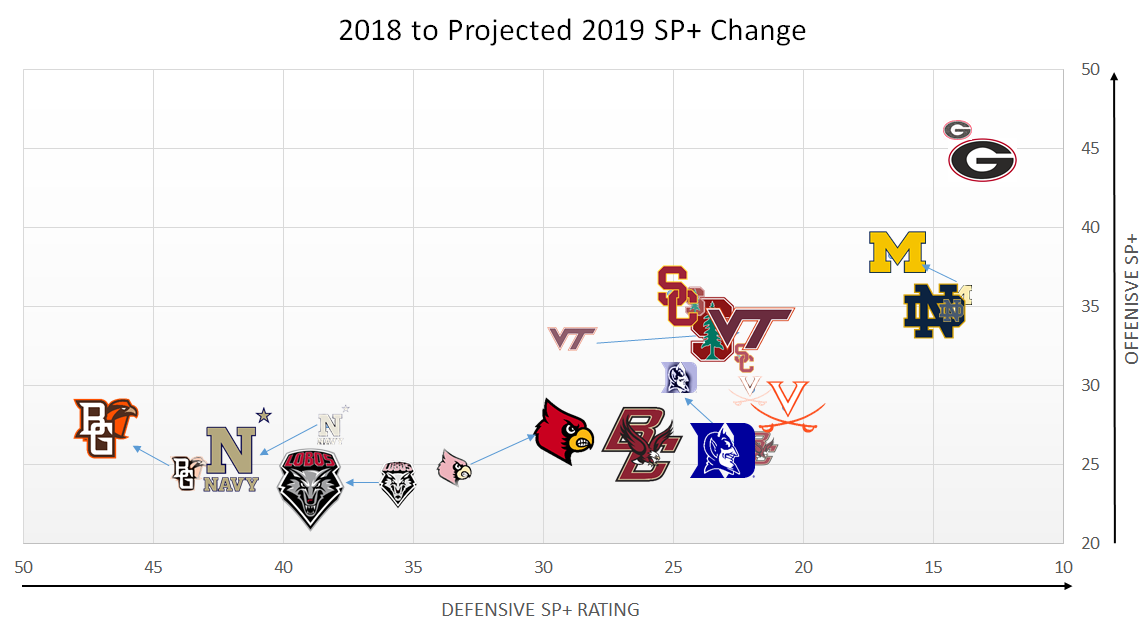
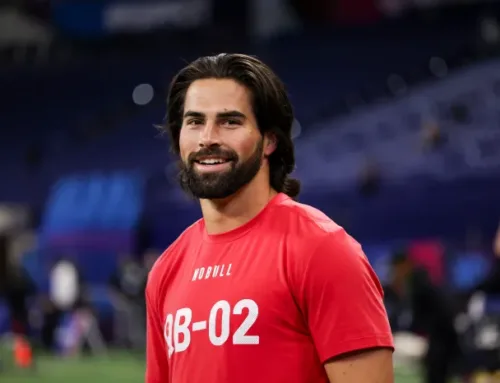
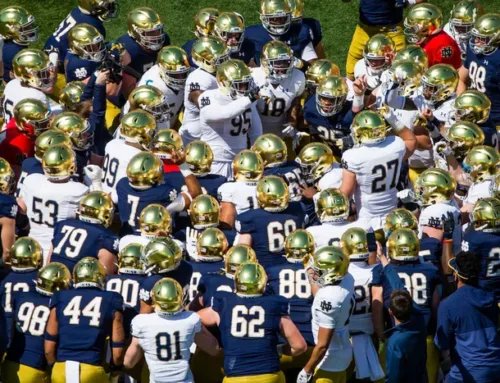
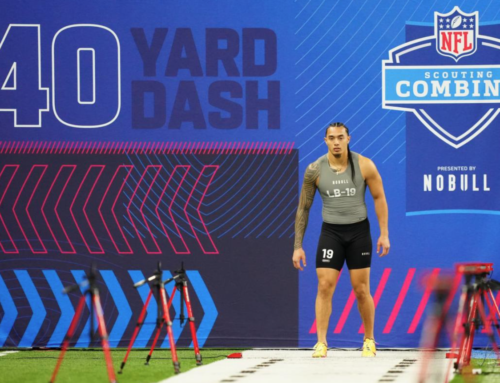
Great stuff. One thing I’m not sure I understand: is the offensive SP+ numbering on the chart backwards? It makes UGA look like the worst offense we will face.
Good question – that chart shows the SP+ rating, not ranking. The ratings are essentially an adjusted points per game type of number, accounting for tempo and opponents, and then overall rankings are determined by Offensive SP+ rating – Defensive. So for offense there bigger is in fact better!
So BVG-led Bowling Green would be the best defense we face? I may be more confused, now.
Or maybe SP+ is a stand-in for potential points scored? So the best defenses are low ratings, and the best offenses are high ratings?
Yes. Now you understand.
Yes this is it, a much more concise and accurate summary of my attempt above haha
I’ve only really seen rankings reported for S&P, so I had no idea the system was so weird for specific ratings. Great education…double my subscription fee! Worth every penny.
Tremendous content, makes me even more excited for the season.
Really great stuff.
USC has to have the widest possible variance of any team of the country going into the season, no? Like, they could go anywhere from 11-1 to 4-8 and I would not be the least bit surprised either way.
This is kind of what I was thinking when rewatching the game from last year. During that broadcast, they showed a graphic of 6-7 games where USC had a 13+ point lead early in the game and went on to lose at least 5 of those games. Additionally, I just found this “They actually held a first quarter lead in 10 of their 12 games and a first half lead in the other two.” They’ve been in their games, just have to figure out how to stay in the games. I hope they don’t figure it out, though.
I mean I kind of hope they figure it out, go 8-4 and keep trotting clay out there with diminishing recruiting returns seems like a solid formula
very supportive of Clay Helton, USC coach for life
Yep, it wasn’t quite to the extent of ND 2016 but they were 34th in S&P+ last year on the way to 5-7. The schedule is so rough I would be pretty shocked by double digit wins but I think their ceiling is definitely a top 20-25 team, which could definitely get them to 9 wins and should win them the south. I think they have to start fast, because if they lose confidence early combining with not being super deep, especially in the trenches, I think the floor is definitely an interim coach death spiral.
My thinking of them potentially being very good is basically because of the shift in offensive philosophy: it’s possible that their awesome WR corps plus JT Daniels taking a leap (IIRC, he skipped a year of high school, so he should only be a true freshman *right now*) could mean they get lots of points.
Of course, things could very much implode too.
Just want to be first to say, more like Jawon Sacked, amirite?